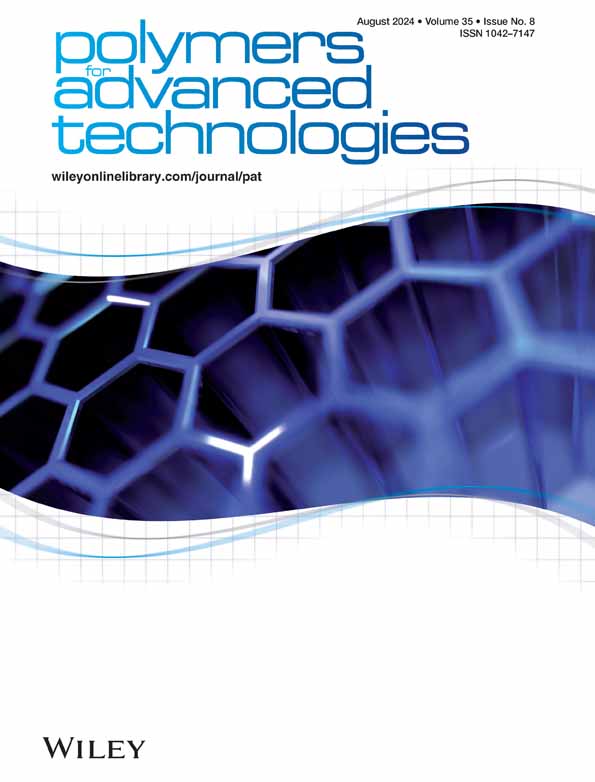聚乙烯醇(PVA)/尿素/二氧化钛纳米纤维膜的缓释肥料特性
IF 3.4
4区 工程技术
Q2 POLYMER SCIENCE
引用次数: 0
摘要
纳米纤维是一种在药物释放材料中用作药物载体基质的材料。其形态具有高孔隙率和良好的柔韧性,因此适用于这一用途。本研究采用电纺丝方法制备了 PVA/尿素/二氧化钛纳米纤维。制备 PVA/Urea/TiO2 SRF 时,尿素的质量百分比(PVA 质量的 10%、15% 和 20%)和二氧化钛悬浮液的浓度(0、0.2 和 0.4 mL)各不相同。使用扫描电子显微镜(SEM)和傅立叶变换红外光谱(FTIR)对每个样品进行了分析,并使用接触角和缓释测试进行了测试。从扫描电子显微镜表征来看,所有样品都能形成纳米纤维。结果发现,各样品 A、B、C、D、E 和 F 的膜直径尺寸分别为 341 ± 5、309 ± 12、109 ± 3、313 ± 10、109 ± 3 和 158 ± 6 nm。傅立叶变换红外光谱特性分析表明,所有基质样品都成功地含有氮基团,其波数分别为 1605 cm-1(NH 变形)、1574 cm-1(CN 伸展)和 3430 cm-1(NH 伸展)。SEM 图谱证实了二氧化钛(绿点)的存在。接触角测试表明,所有样品都具有亲水性(接触角值小于 90°),样品 C/E(含有最多二氧化钛悬浮液 0.4 mL 的样品)的接触角测量值最大,为 31.08°。TiO2 悬浮液浓度最大的样品(0.4 mL)的尿素释放时间最长,持续了 8 天。这一结果表明,添加 TiO2 有可能抑制 PVA 膜的亲水性。研究发现,TiO2 的添加影响了膜的亲水性,从而提高了释放率。本研究使用 Korsmeyer-Peppas 数学动力学模型表明,扩散和溶胀是 SRF 膜的释放机制。本文章由计算机程序翻译,如有差异,请以英文原文为准。
Slow‐release fertilizer behavior of polyvinyl alcohol (PVA)/urea/TiO2 nanofiber membrane
Nanofiber is a material used as a drug carrier matrix in drug release materials. Its morphology has high porosity and good flexibility, making it suitable for this purpose. The use of nanofiber as a carrier matrix in slow‐release fertilizer (SRF) material is expected to provide a solution for releasing fertilizer into the soil more measurably and efficiently In this study, PVA/Urea/TiO2 nanofibers were fabricated using the electrospinning method. PVA/Urea/TiO2 SRFs were prepared using varying urea mass percentages (10%, 15%, and 20% of PVA mass) and the concentration of titanium dioxide suspension solution (0, 0.2, and 0.4 mL). Every sample was analyzed using scanning electron microscopy (SEM) and Fourier transform infrared (FTIR) and tested using contact angle and slow‐release tests. From SEM characterizations, all samples showed the ability to form nanofiber. It was found that the membrane diameter sizes for each sample A, B, C, D, E, and F were 341 ± 5, 309 ± 12, 109 ± 3, 313 ± 10, 109 ± 3, and 158 ± 6 nm, respectively. The FTIR characterizations showed that all the matrix samples successfully contained the nitrogen group, which was found at wave number 1605 cm−1 (NH deformation), 1574 cm−1 (CN stretching), and 3430 cm−1 (NH stretching). The SEM mapping images confirmed the presence of titanium dioxide (green dots). The contact angle test showed that all samples had hydrophilic properties (the contact angle value lower than 90°), and the greatest value of contact angle measurement was 31.08° for sample C/E (sample with the most presence of TiO2 suspension solution 0.4 mL). The sample with the greatest TiO2 suspension concentration (0.4 mL) had the longest urea release time, lasting 8 days. This result indicates the addition of TiO2 , can potentially suppress the hydrophilic properties of the PVA membrane. It is found that the addition of TiO2 influenced the membrane's hydrophilicity, consequently increasing the release rate. This study used the Korsmeyer–Peppas mathematical kinetic model to show that diffusion and swelling are release mechanisms for SRF membranes.
求助全文
通过发布文献求助,成功后即可免费获取论文全文。
去求助
来源期刊

Polymers for Advanced Technologies
工程技术-高分子科学
CiteScore
6.20
自引率
5.90%
发文量
337
审稿时长
2.1 months
期刊介绍:
Polymers for Advanced Technologies is published in response to recent significant changes in the patterns of materials research and development. Worldwide attention has been focused on the critical importance of materials in the creation of new devices and systems. It is now recognized that materials are often the limiting factor in bringing a new technical concept to fruition and that polymers are often the materials of choice in these demanding applications. A significant portion of the polymer research ongoing in the world is directly or indirectly related to the solution of complex, interdisciplinary problems whose successful resolution is necessary for achievement of broad system objectives.
Polymers for Advanced Technologies is focused to the interest of scientists and engineers from academia and industry who are participating in these new areas of polymer research and development. It is the intent of this journal to impact the polymer related advanced technologies to meet the challenge of the twenty-first century.
Polymers for Advanced Technologies aims at encouraging innovation, invention, imagination and creativity by providing a broad interdisciplinary platform for the presentation of new research and development concepts, theories and results which reflect the changing image and pace of modern polymer science and technology.
Polymers for Advanced Technologies aims at becoming the central organ of the new multi-disciplinary polymer oriented materials science of the highest scientific standards. It will publish original research papers on finished studies; communications limited to five typewritten pages plus three illustrations, containing experimental details; review articles of up to 40 pages; letters to the editor and book reviews. Review articles will normally be published by invitation. The Editor-in-Chief welcomes suggestions for reviews.
 求助内容:
求助内容: 应助结果提醒方式:
应助结果提醒方式:


